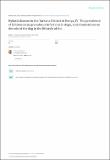Hydatid disease in the Turkana district of Kenya, IV. The prevalence of Echinococcus granulosus infections in dogs, and observations on the role of the dog in the lifestyle of the Turkana.
View/
Publication Date
4/14/1983Type
Article, Journalviews
downloads
Metadata
Show full item recordCitation
Macpherson CN, French CM, Stevenson P, Karstad L, Arundel JH. Hydatid disease in the Turkana District of Kenya, IV. The prevalence of Echinococcus granulosus infections in dogs, and observations on the role of the dog in the lifestyle of the Turkana. Ann Trop Med Parasitol. 1985 Feb;79(1):51-61. doi: 10.1080/00034983.1985.11811888. PMID: 3985706.
Abstract/
The prevalence of Echinococcus granulosus in dogs in the Turkana District of Kenya was 39.4% of 695 examined. Of these, 98 (35.8%) had heavy Echinococcus worm burdens (10(3)-5 X 10(4) ), while 54 (19.7%) and 122 (44.5%) had medium (201-1000) and light (1-200) burdens. The possible sources of these infections are discussed. The prevalence rate differed in various parts of the district, ranging from 63.5% in the northwest, where the highest incidence of human hydatidosis also occurs, to nil along the shores of Lake Turkana. Infection rates of 32.0% and 16.7% were recorded at Lokitaung (north-east) and Lodwar (central), while in the south 48.9% of dogs harboured Echinococcus. This latter figure is surprising as the area has a low incidence of human hydatidosis. The Turkana keep a large number of dogs, and the reasons for this and the social role of the dog in the district is discussed. No difference in susceptibility was found between Turkana-type dogs and those of mixed breeds from Nairobi when they were experimentally infected with hydatid protoscolices from man, camels, cattle, sheep and goats. However, it proved difficult to infect the Turkana-type of dogs with viable protoscolices of cattle origin. The reasons for this and its epidemiological implications remain unclear. It is suggested that droughts, which affect Turkana every six to ten years, may play an important role in the perpetuation of hydatid disease in the area.
Publisher
Liverpool of Tropical MedicineCollections
- General - GEN [367]

